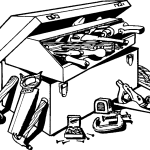
This book was created for people who are new to Research Data Services programs and, as such, covers some basic principles as well as more advanced techniques that can help get an RDS program started at a university Library. One of the goals of the “Research as Data-Data as Research” project was creation of a toolkit to provide a step by step guide for libraries, especially those with limited resources, to prioritize needs and create offerings with the assistance of their user communities. This toolkit is a collection of those resources, separated by the phase of the project. It is intended to be an evergreen, open resource. Please feel free to contribute ideas and examples that you think other libraries will benefit from.
How to Use This Book
This Tools for RDS book is designed as both a linear guide as well as a reference text. Each chapter covers a specific stage of the process in establishing an RDS program, and individuals who are starting from scratch will find information to help them at every step of the process.
In order to present many of the concepts in this book in a clear, relatable, and easy-to-understand fashion, we have created a fictional Case Study involving a Research Librarian at a medium-sized land grant university. The purpose of this Case Study is to illustrate how to apply many of the tools and techniques covered in the text, as well as give examples that demonstrate situations and scenarios that you might find yourself in as you create an RDS program.
Chapter Overviews
Start from where you are
Fill in the gaps
Make it happen
Communicate, communicate, communicate
You can’t do it alone
Learning Objectives
After reading this book, you should know, learn, or be able to do the following:
Conduct an inventory of current tools and resources
Describe different types of stakeholders and identify key stakeholders within your own Library
Apply principles of equity-centered design to the foundational building blocks of an RDS program
Understand basic principles of managing a large-scale project
Describe the purpose of a Memorandum of Understanding and how this type of document benefits all parties involved.
Create a communication plan for ensuring effective teamwork among relevant project stakeholders
Evaluate the effectiveness of the RDS program

